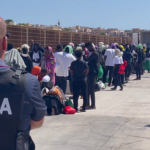Only a year ago, in 2014, the most important route into Europe for migrants was across the Mediterranean sea, in boats of up to 800 passengers from the North African coast to Italy (Lampedusa sas primary destination) or Malta: the southern route. So far in 2015, migration along the alternative eastern route has rised.
[subscriptionform]
[level-european-affairs]
Matter of fact, during 2012 a fence was erected on the border between Turkey and Greece, forcing migrants to take boats from the Turkish coast to nearby Greek islands or travel north to the Bulgarian border. In 2014, Bulgaria began building its own fence to prevent this.
In September 2015 alone, 156,000 immigrants took the eastern route compared to just 7,000 in the same month the previous year.
The Schengen area makes things easier once the migrants have entered Hungary or Slovenia, but, on the other hand, things are getting much harder to deal, to administrate for these countries. In early July, Hungary began building a fence on its Serbian border, forcing the migrants on the west route through Croatia, often entering Hungary from there and a second fence was built on the Croatian border in October, pushing people up to Slovenia. Actually, Slovenia is building a fence itself. Balcans countries are struggling in order to face the situation. Albanian Government has already stated that the country will make what’s in it’s possibilty to mitigate the pressure in the area.
European countries are forced, under pressure, to find long term solutions, Germany in first place.
Angela Merkel, German Chancellor and most powerful woman in the planet, is facing risks on her own political body, over migrants crise . When migrants began to arrive in large numbers over the summer, she announced publicly that they were to be welcomed rather than turned away. Considering that an imponent number of Syrians living in Turkey have been able to make a living only because of temporary employment or casual labor, but , as Turkish economy has begun to deteriorate, unemployment has grown by being unaffordable, those Syrians are also leaving Turkey. So, what’s next?
Germany is home to the vast majority of past Turkish immigrants into Europe, and tensions have long been high over the issue. Syrians have a explicit and strong case for asylum, and it is extremely hard to repatriate them. The European Union wants to keep the Balkan countries from confronting one another over migrant flows. At the same time, the bloc wants to keep borders within Europe as open as possible to preserve the union’s structure while apportioning them fairly across the Continent. The Oct. 25 summit likely discussed all of the possible solutions along the migrant route and most summits during last two years have tried the same.
As temperatures drop immigrant flow will arrest the emergency. The latest flows have also revealed a drop in the portion of migrants from Syria and a rise in Afghan and African migrants, partly because of cheap Turkish Airlines flights to North Africa. Unlike Syrians, authorities will find it much easier to send back migrants from these points of origin.
But the fact is that war keeps on radicalizing in Syrian territories, which is much more than a preview on warmer season to come: migrants are most likely not stopping their desperate journeys.
Sabiena Stefanaj
[/level-european-affairs]







